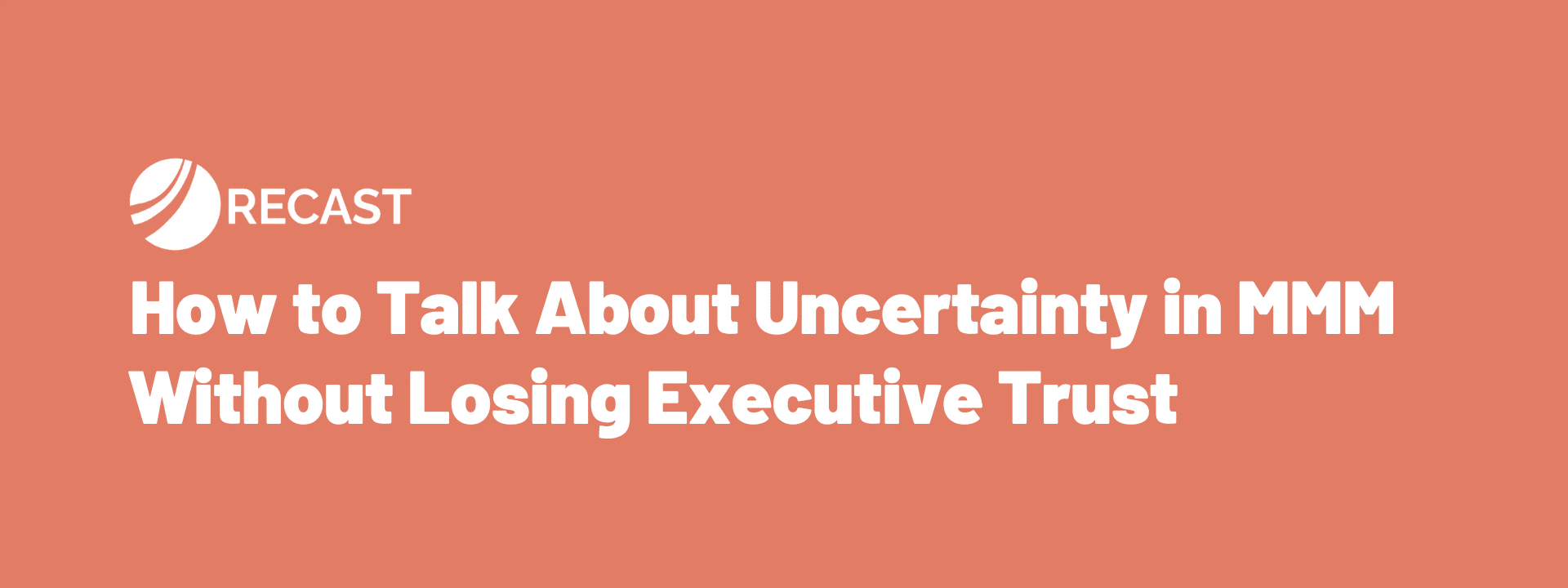Media mix modeling introduces statistical rigor, causal inference, and a more accurate picture of what’s driving growth across your marketing channels. But it also introduces uncertainty — and if that measurement uncertainty isn’t framed correctly, it can feel like confusion rather than clarity.
That’s why so many MMM efforts stall at rollout. Not because the math is wrong, but because the message wasn’t ready. The numbers didn’t match expectations. The implications weren’t properly communicated. And the organization, trained on deterministic dashboards, wasn’t prepared to reason probabilistically.
If you want to make MMM work inside your org, you need to get good at one specific skill: communicating uncertainty without losing executive trust.
Why Uncertainty Feels Risky (and Why It Isn’t)
One of the biggest psychological hurdles in adopting MMM is learning to talk about uncertainty with confidence.
In traditional marketing measurement, uncertainty is often invisible. Last-touch attribution, platform ROAS, in-platform dashboards — they all present themselves as precise and unambiguous. The numbers are clean. The outputs are deterministic. And that gives executives a false sense of certainty — even when the underlying assumptions are deeply flawed.
So when a marketing leader shows up with a media mix model that says, “This channel has an ROI between 2.1x and 3.4x,” it can sound like a lack of clarity.
Executives start asking:
- “Why don’t you know the exact number?”
- “What happened to the ROAS I used to see in Google Analytics?”
- “Are you saying we’ve been making bad decisions for the last three years?”
And those reactions are totally rational because most executive teams were trained (often by marketing itself) to trust deterministic systems. To look at GA or their BI dashboard and assume those numbers were not just operationally useful, but directionally true.
What MMM does is surface the uncertainty that attribution systems hide. It makes assumptions explicit. And it forces teams to confront the reality that in a complex, omnichannel business, there is no single answer—just a range of likely outcomes under different conditions.
That’s not a weakness. Uncertainty is not a lack of rigor. It’s the outcome of more rigor.
And yet, analysts and marketing scientists often feel stuck. They know their work includes uncertainty, but they also know their CEO just wants an answer.
That tension is very real. But it’s also solvable. It starts by shifting the frame:
Uncertainty isn’t a liability to be hidden. It’s what lets us have better conversations about confidence, risk, and tradeoffs. Because when you understand uncertainty, and learn to communicate it well, you actually earn trust.
Where MMM Rollouts Fail: It’s Not the Model, It’s the Message
When media mix modeling fails inside organizations, it’s often because the communication fell flat.
Smart analysts and marketers walk into executive meetings with a model that might be technically sound… but it lands like a lead balloon. Why?
Because they skip the part where they prepare the organization for what’s coming.
They show up with a chart that contradicts the ROAS number the CFO’s been looking at for 18 months. They lead with confidence intervals and new methodology before aligning on business goals. They present uncertainty in MMM as a caveat instead of positioning it as a strength. They say, “The model shows YouTube is 3.5x ROI,” and get met with, “But GA says it’s 1.2x — what changed?”
And in that moment, the trust starts to erode.
From our experience, executives don’t reject MMM because they dislike nuance. They reject it because no one helped them make the conceptual shift:
- They weren’t briefed on the limitations of attribution.
- They weren’t walked through how MMM works differently, or why the old systems weren’t showing the full picture.
- They weren’t given the space to reorient their mental models before being asked to make new decisions.
How Incrementality Bridges the Gap Between Marketing and Finance
Marketing leaders talk about constantly battling for budget. And at the root of that tension is a fundamental disconnect: the marketing team and the finance team just aren’t speaking the same language.
Marketing talks about impressions, conversion rate, and clicks. Finance talks about revenue, costs, and profit. And they end up not really being able to communicate.
When marketing teams adopt and embrace the idea of an incrementality system, it changes the relationship.
All of a sudden, there’s a shared language. Marketing can say:
- Here’s the budget we’re proposing.
- Here’s the investment.
- Here’s what we expect to get on the other side.
- Here’s the forecast.
- Here’s the uncertainty in the forecast.
- And here’s how we’re pacing against that forecast based on recent trends.
That’s music to a CFO’s ears.
Now, instead of marketing talking about impressions and finance talking about profit, both teams are working from the same framework. They can have productive conversations about trade-offs: we can save money here, but it’s going to cost us there. We can invest here, and here’s what we expect the benefit to be — but there’s some uncertainty.
That’s a much more strategic conversation. It doesn’t mean impressions and clickthrough rate aren’t important. They are. But those aren’t the metrics to lead with in a finance conversation.
The key to success is translating uncertainty into the language of business decision-making. Before your next executive presentation, prepare stakeholders individually, focus on outcomes rather than methodology, and frame confidence intervals as strategic guardrails rather than statistical caveats.
When you position MMM’s probabilistic insights as a more honest foundation for strategic planning, you transform what could be perceived as an analytical weakness into a decision-making strength.
Recap: How to Talk About Uncertainty Without Losing Trust 🔁
- MMM introduces uncertainty — but that’s a strength, not a flaw
- Confidence intervals show strategic ranges, not vagueness
- Executives need context: what changed, why, and how it connects to decisions
- Framing uncertainty well builds trust, especially when paired with incrementality forecasts
- Success depends on the story, not just the stats



